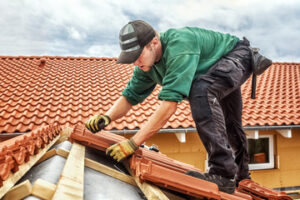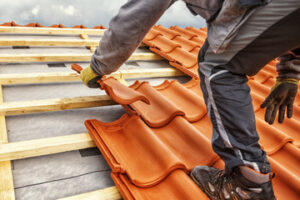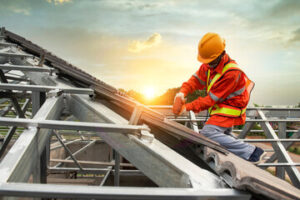Like any other aspect of your home, the roof needs regular maintenance to keep it looking good and functioning well. It can deteriorate over time, or suffer extreme physical damage.

The first thing you need to do is assess the roof’s condition. Water intrusion and rot are a sure sign that repairs are needed. Visit Website to learn more.
BUR roofing is a multi-layered system that combines reinforcing fabrics, bitumen and surfacing materials such as gravel to create a durable, long-lasting roof. A time-tested option with a legacy that spans over 100 years, this system has proven its reliability and efficiency.
These layered structures are ideal for flat or low-sloped structures. Their durability and weather resilience make them a common choice for industrial facilities, commercial warehouses and large retail centers. Additionally, their versatility allows them to act as a base for vegetative roofs, solar arrays and outdoor living spaces.
The layered structure of a BUR roof means that it can offer more insulation than most other roofing systems, which in turn lowers your energy costs and emissions. A BUR roof also has a high puncture resistance, which reduces the likelihood of an emergency leak due to an accidental penetration.
While the layered structure of a BUR roof makes it more durable, it can be susceptible to surface damage and aging. As such, it is essential that any damaged areas of your roof are repaired as soon as possible to avoid costly repairs in the future.
BUR roof repair requires the services of a reputable commercial roofing contractor to ensure that the job is done correctly. These experienced contractors can effectively assess the damage and determine the best course of action for repairs. They can also recommend additional roofing upgrades to help your facility improve its energy efficiency.
A BUR roof can be made more energy efficient by incorporating a rigid insulation layer. This adds an extra level of protection to the existing ply sheets and can significantly reduce your building’s heating and cooling costs. Alternatively, you can opt for a reflective cap sheet to minimize the amount of heat absorbed by the building and reduce your utility bills.
A well-maintained BUR roof can last for over 30-40 years, depending on its location and climate. These long lifespans are a direct result of the dependable, resilient design that makes this roofing system so popular.
Although some DIY methods may claim to save you money on roof repairs, these shoddy DIY solutions can compromise the integrity of your building and jeopardize the validity of your manufacturer’s warranty. Instead, contact an Elevate commercial roofing contractor as soon as you notice damage to your BUR roof.
Shingles
Shingles are one of the most popular roofing materials for homeowners because they’re affordable and durable. But even the sturdiest roof shingles can suffer damage, whether from harsh weather conditions or unforeseen accidents. Damaged shingles can compromise the integrity of your roof, leading to leaks and other issues. The good news is that repairing shingle damage is usually fairly easy. The following shingle roof repair tips from the experts can help you keep your roof in good shape.
The first thing to do when you notice a damaged shingle is to remove the nails that hold it in place. You may need to use a pry bar or a hammer to do this. Before you start, make sure you choose a day that’s not too hot or cold, since the sealant bond between the shingles can crack or break if it’s too warm or cold.
Once you’ve loosened the shingle, slide the pry bar underneath the row of shingles directly above the damaged section and lift upwards. This will loosen the sealer strip and expose the first row of nails beneath. You’ll want to repeat this process on all the shingles above the damaged shingle.
Next, use a putty knife to apply a thin layer of roofing sealant over the cracked or torn shingle. Be sure to cover any exposed granules with the sealant as well, for a more seamless and watertight repair. Then, weigh the shingle down with a brick, and leave it in place for 24 hours to allow the sealant to fully dry.
When you’re done repairing cracked or torn shingles, it’s a good idea to check your gutter for an accumulation of shingle granules. These can be sprinkled over the wet sealant to camouflage your repair.
If you need to replace a damaged shingle, do it as soon as possible. This will prevent further damage to the rest of your roof. And make sure that the replacement shingle matches your existing shingles in color and style, so it blends seamlessly into your roof. This will ensure a uniform appearance and help your roof resist moisture-related problems in the future.
Fascia
Fascia is the board that supports gutters and adds an aesthetic element to your roofline. It is also a vital part of your roof, protecting the rafters and trusses from moisture damage and preventing water ice dams. It is important to inspect fascia boards on your home regularly for signs of rot, decay, or insect infestation. If you notice these signs, contact a local roofing contractor to repair the soffit and fascia materials as soon as possible.
The term fascia is used to describe various types of fibrous connective tissue in the human body, including deep fascia, which surrounds and divides individual muscles and separates muscle groups into fascial compartments. It was once thought that fascia was just a natural bandage, but it is now recognized as an integral part of the structure and function of the body.
In the context of a house, fascia boards are made from wood, aluminum, vinyl, or polyvinyl chloride (PVC), and can be painted to match your home’s color scheme. Each material offers different levels of durability, weather resistance, and aesthetic appeal. Wood fascia is best suited for homes with traditional or rustic architecture, while aluminum and PVC are suitable for modern styles.
When choosing a new fascia board, make sure to choose one that is properly sized for your roof. Oversized boards can cause rot, while undersized ones will not provide adequate support. It is also a good idea to choose one with a drip edge, which helps keep water away from the edges of your roof. It is also important to install a metal gutter system to prevent clogs that can lead to leaks and other problems.
Fascia repairs can be performed by a professional roofer, gutter specialist, or carpenter. Before making the repairs, be sure to remove any soft or rotting sections of the board. You can then use wood filler or a similar product to repair the damage and protect against further issues.
When repairing fascia, it is important to choose a high-quality wood filler that will protect against moisture and insects. It is also a good idea to use galvanized or anti-corrosion nails to ensure that your fascia boards are secure. When the repair is complete, be sure to paint the area with a waterproof sealant to help protect the wood.
Flashing
Many homeowners don’t think about the specific materials on their roof and how important they are to keeping a home well-protected. One of the most crucial pieces of roof material is flashing, a thin strip of waterproof material that’s installed at critical points like roof intersections and projections, and around chimneys, dormers, vent pipes, and window openings. Flashing keeps water from entering through these crevices, directing it to areas where it can drain away.
Leaks can occur when flashing isn’t properly installed or maintained, especially if it’s not sealed at the joint between two distinct parts of the roof system or around a penetration point. A leaky roof can lead to rotted framing and sheathing, ruined insulation, mold and mildew growth, and stained ceilings.
If you notice any issues with your roof flashing, it’s important to contact a professional roofing company to repair the damage and prevent further problems from occurring. A professional can help you determine the best type of flashing to use for your particular roofing system. Depending on the climate where you live, galvanized steel, aluminum, or copper flashing may be more appropriate than other types.
Once the new flashing is in place, it’s important to reseal the area where the seal is broken. Using caulking is usually enough, but you should also consider using roof cement. This will ensure the seal is tight and durable, preventing further water damage to your roof and the inside of your home.
In addition to repairing leaks, a roofing professional can also help you with other repairs to your roof, such as replacing shingles or repairing damaged siding or fascia. It’s a good idea to schedule an inspection of your roof at least once a year to make sure everything is in tip-top condition and that there are no signs of leakage or other damage.

